Sound quality
Let me get one thing very clear right off the bat when it comes to how these new ‘x’ series Grados sound: they have not thrown the baby out with the bathwater. The SR80x and SR325x are still very much Grado Lab headphones to the core in terms of the way they sound, and yet they’ve definitely tinkered under the hood with the addition of this new 4th-generation 44mm driver. With both the SR80x and SR325x you’ll be getting a dose of that famed energetic, clear and open sound with an uncanny ability to make voices and instruments simply come alive. The addition of the ‘x’ the to SR80 and SR325 model designation brings with it a dose of extra refinement and versatility that make these newest Grado models an even more enticing proposition to listeners who might not have considered a Grado headphone previously – The Hemp Headphone was very much a portent of an evolution of ‘The Grado Sound’ that was to come.
SR80x
The SR80x made me sit up and notice right out of the box with an immediately fuller, smoother, and weightier sound than the outgoing SR80e which, by comparison, has a more lean and slightly brittle presentation which is very much lower treble-oriented. The SR80x still very much has a forward, immediate presence region that emphasises the vocals and instruments in a mix, but it’s less shouty this time around thanks to an overall more linear tuning that is balanced out by a more pronounced bass and smoother, silkier top-end.
In terms of overall voicing, the SR80x is a precise, open and airy-sounding headphone that most certainly tilts clear/bright over the warm side of the tonal equation. In terms of spatial abilities, the SR80x immerses you far more than a pair of $125 headphones ought to. Their staging isn’t overly vast as open-back headphones go, but the way that they’re able to create a sense of air and envelopment in Morcheeba’s ‘Sounds of Blue’ is bloody impressive.
The star of the show on the SR80x is its wonderful mid-range presentation that makes instrumental and vocal tones and texture feel entirely natural. Live music, in particular, is a treat on the SR80x. The drum/cymbal hits in ‘In Session’, a live recording of Stevie Ray Vaughan and Albert King land with perfect impact and depart with perfect decay – these drivers are quick, capable, and have great dynamic abilities. ‘Blues at Sunrise’, a 15-minute jam between the two guitar legends on the same album is simply awesome. SRV’s guitar simply wails over the SR80x but doesn’t get quite so hot (and potentially grating) as older SR80’s could tend to.
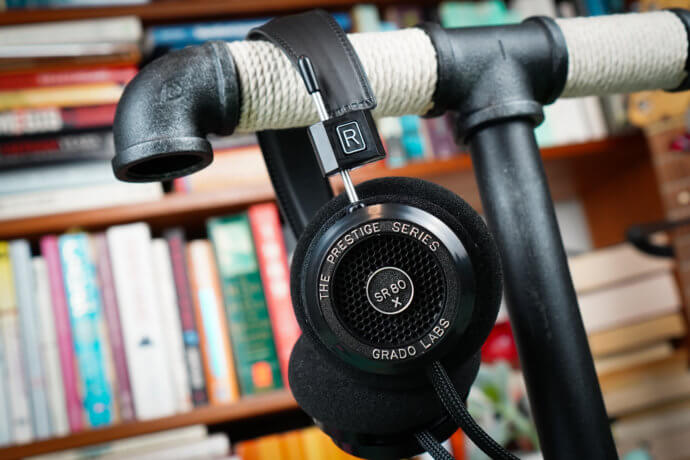
The most substantial difference that should make those who might have been previously on the fence about a pair of Grados is the arrival of a more extended and impactful low end. The SR80/e was always able to play bass, but was neither head-shaking nor terribly well extended, with substantial bass roll-off below 80Hz. The SR80x isn’t exactly is pair of subwoofers (just to manage your expectations), but Massive Attack’s ‘Angel’ actually hits with some nice, visceral impact in the low end. The bass in the SR80x doesn’t make it a warm pair of headphones by any stretch, but it does help make it an evenly-balanced one overall – and not just by Grado standards.
The biggest sonic change in the SR80x, to my ears, is a far smoother and restrained treble. There’s still great extension and a crispy ‘bite’ to notes and you won’t be disappointed if you like a ‘bright’ pair of cans by any means, but the Grado really has added a dose of refinement here, reigning in the tizz and excess energy that could at times be a bit like someone starting a motorbike in your back lane at 6 am on a Sunday morning – cool and all, but just a bit too much when you’re not in the mood. This makes the SR80x a slightly better match when it comes to poorer recordings, or more aggressive tracks with lots of cymbal energy like Metallica’s ‘For Whom The Bell Tolls’.
SR325x
The SR325 has often been dubbed the ‘brightest’ or most aggressive Grado, so it was interesting swapping over to them after spending a week or so solely listening to the SR80x. The first thing you notice is that the SR325x – sounds a lot LOUDER. At first, I thought they were a bit more sensitive, and required a slight left twist on the volume pot of the Asgard 3 to get to a similar listening level. A quick pad swap between to two revealed that the mechanical impedance of the extra foam on the ‘S’ pads attenuates the sound from the drivers a fraction, and their drivers are indeed similar in terms of power requirements.
The SR325x makes the SR80X feel a little thinner and etched sounding compared to the more full-bodied, fulsome timbre of the SR325X. It’s undoubtedly a more classically ‘Grado’ sound, but the 325X clearly has the edge in terms of refinement, detail, and layering from the get-go. There’s just more air, space as well as a blacker background around notes with the more expensive, and clearly more capable SR325x. The largest difference that the SR325x has over its junior sibling is a more immediate, forward upper midrange and lower treble, which makes Radiohead’s performance of ‘Bodysnatchers’ from In Rainbows sound urgent and exciting, whereas the SR80x is a little more restrained and withdrawn (comparatively). It’s definitely a coloured headphone and by no means ‘reference’ and may take some getting used to if you haven’t spent much time listening to Grados, but after settling into a few tracks with them this has the distinct effect of making the SR325x feel even more akin to a live performance – it’s an extremely intimate and emotive affair, especially when moving to the next track on In Rainbows, ‘Nude’. It’s here that the SR325x’s treble talents step into the limelight, digging deeper into the mix and creating a far more speaker-like effect in terms of separation and depth, while the SR80x creates a more headphone-like ‘around-ear’ effect. I had one moment where I genuinely had to check that I didn’t have my headphone amp running pre-outs to my speakers when playing Tame Impala’s ‘One More Hour’ – the distant reverb of the pianos really was a bit mind-bending. This track also divulges the natural sense of decay and realism that the SR325x is capable of in the upper treble, with a believable and natural tone that casts a brilliant sense of sparkle across a track that other headphones – planars in particular – are just less convincing when doing so.
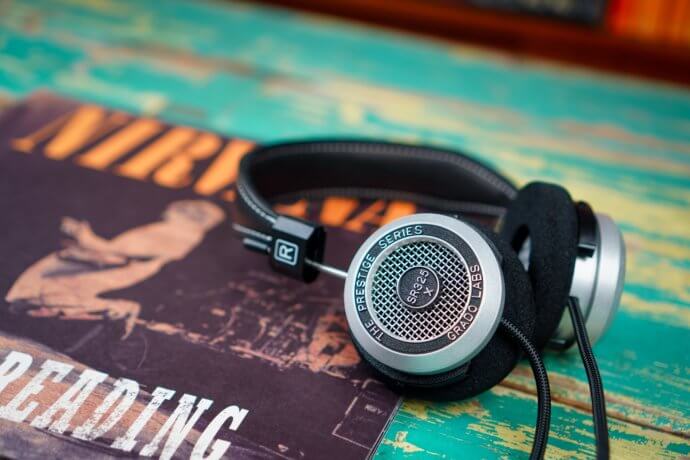
Like the sonic evolution that’s happened in the SR80x, the most noticeable adjustment that’s been made to the SR325x, for me, is in the way the top-end has been refined over the SR325e. The outgoing ‘e’ model was very much a master-class in providing unadulterated clarity, air and sheen, so it’s interesting that the SR325x has smoothed this over gently for a more linear transition from mid-range to treble, with a bit less shout’ and a whisker less sparkle up top. I wouldn’t go so far as to say that Grado has clipped the wings of the SR325 with the new ‘x’ model – far from it – but they have made a more all-around and approachable headphone while maintaining what makes it a technical and tonal delight.
While the SR80x has a satisfyingly taut and precise bass, it’s just not able to extend nor slam to the same degree as the more weighty and overall warmer-sounding SR325X, which is simply a more all-round, and more impressive performer in this regard. The SR325x has some genuine mid-bass clout in its fourth iteration, its 44mm drivers are capable of some real dynamic punch and add a real sense of genuine warmth to the overall tone, extremely reminiscent of The Hemp Headphone, and a noticeable lift over the SR325e. Faith No More’s ‘Evidence’ proves the SR325x to have not only a bit of low-end shove but dexterity as well, being able to nimbly transition between bass guitar notes without ever getting sloppy or spoiling that fantastic party that’s happening in the mid-range.
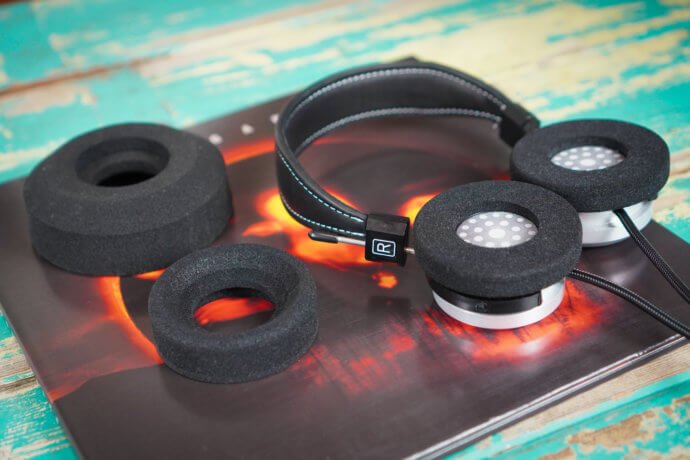
So, having gotten comfortable with the out-of-the-box tuning of the SR325x, it was time to see why Grado decided to equip them with the F-Cush flat pads over the previously-used L-Cush pads – or any other pads, for that matter. The L-Cush pads don’t quite keep the drivers off your ears, but they do stop the clamping force of the SR325x from shoving them directly into your ears. Immediately, I was grateful for the relief this gives in terms of comfort but then realised after dropping the needle on Rage Against The Machine’s self-titled album that this created a huge change in tuning. Gone is much of the newfound warmth and lower mid-range presence, but a degree of the 325e’s clarity and signature attack is rediscovered in the upper register – especially in guitar and cymbal tracks. It’s interesting that Grado owners will be able to pad swap (a five-second operation) and be able to tune to their sonic preference accordingly. While I enjoyed spending an album’s worth of a more ‘classic’ Grado sound, I found that I was missing the more balanced and meaty sound that the F-Cush provides the SR325x. It’s clear that the Grado clan have voiced this to be a crowd-pleaser, and the decision to use the F-Cush pads here is the correct one.
Seeing as I had my Grado pad drawer open on the review desk, I popped on the largest ‘G-Cush’ pads that Grado equips on its highest-end Statement and Professional series headphones. These turn the SR325x into a genuine over-ear headphone and make them actually, properly, comfortable. They also turn them into a different headphone altogether – they become a V-Shaped soundstage monster. This widened stage is not only courtesy of pushing the drivers further away from your ears but by sucking out that wonderful mid-range to create a greater sense of being immersed in a performance space. Bass impact is lessened overall, but the bass received greater clarity and presence in the mix due to that signature mid-range ‘shout’ being effectively removed. Again, it’s an interesting prospect that you can tune the SR325x to become almost three different headphones, but I didn’t really enjoy the G-Cush on the SR325x, except when playing bass-heavy music like Run the Jewels which sounds a little too congested on the stock pads.
Head over to page 4 for powering and pairing, and headphone comparisons.







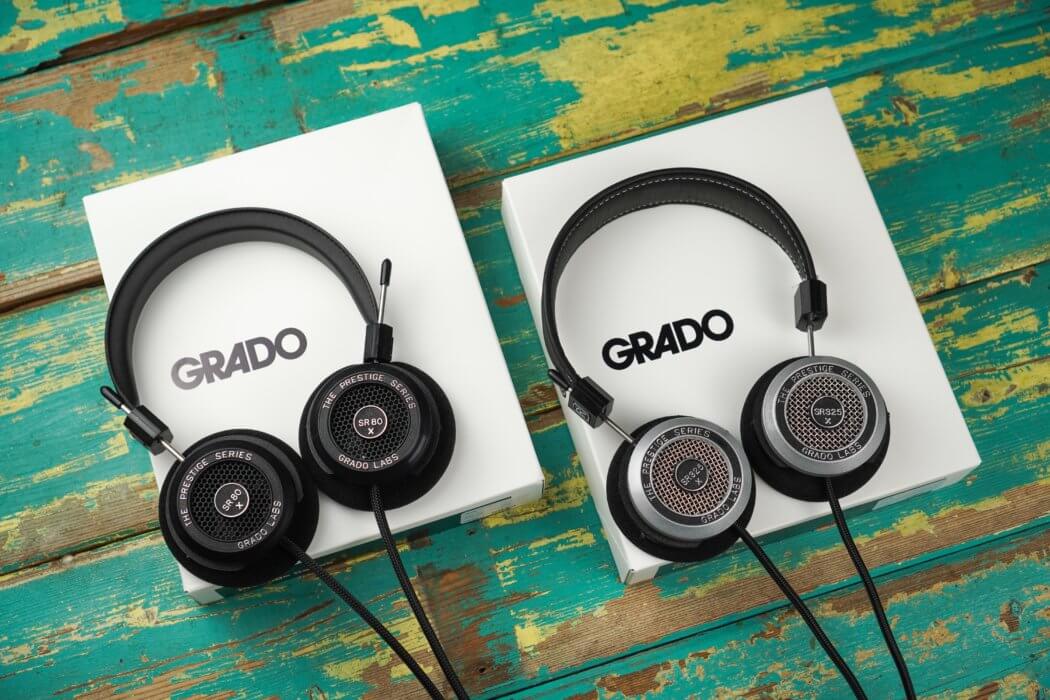
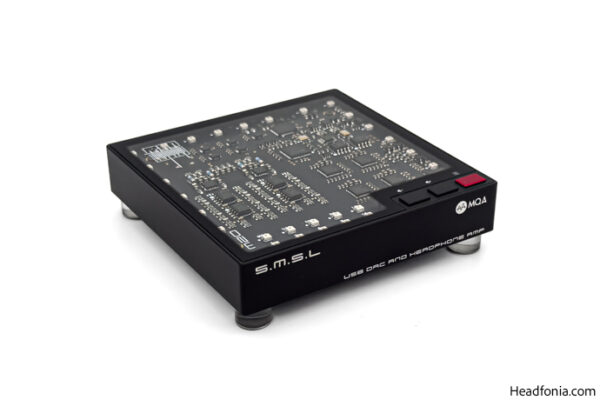
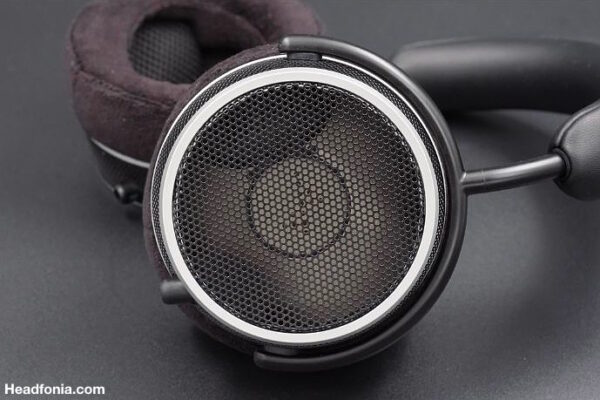
xtvym
Nice review Matt!
Lee Brown
Very detailed review, which was great. I have an original SR-60, but have been using IEM of late. Maybe an upgrade could be in order. By the way, that is Albert King, not B.B. on the “In Session” album.
Matty Graham
This new range does sound noticeably different enough to at least warrant an audition! Thanks for the pick-up BTW, it was rather late when I was doing my listening…
Tibor
Fidelice Precision Headphone Amplifier YES PLEASE! I have just a quick question, is it any different internally from older RNHP or just a new look to match new line?
Thanks for review, I found my Hemps already very dynamic, if these 325x are even more, with better bass, I am in 🙂
And you will hate me for this one (again), can we get at least 1080p pics pls?
Have a great day!
Himansu
Nice information
Adrian
Hello, thx for this interesting review!
How does the Grado GW100 compare to these two ? Is it close to the SR80X or more on the SR325X side? (especially in wired mode)
Thx!
kelfab
Hello, when you say “While I enjoyed spending an album’s worth of a more ‘classic’ Grado sound, I found that I was missing the more balanced and meaty sound that the L-Cush provides the SR325x. It’s clear that the Grado clan have voiced this to be a crowd-pleaser, and the decision to use the L-Cush pads here is the correct one. ”
Didn’t you switched by mistake between F anf L Cush in these 2 sentences ?
Matty Graham
You are correct – thanks for the pick-up!
Loz
Hi. As as 325x owner who was rather underwhelmed by them when paired with a Zen DAC V2, which I also felt did little over my phones dongle DAC apart from add volume, I recently bought the Mojo 2, and am again also underwhelmed by the Mojo 2 with the 325x. An in shop audition never really is sufficient. I’ve tried Tidal masters, Apple Music, and local hi res files on my PC, and feel all of the above really offers nothing over some older £100 headphones plugged into my phone. I’ve tested my hearing and could hear 18k so don’t feel that is the issue.
So my question is as someone who has also reviewed the Dan Clark Aeon 2 Noir, would the Noir offer a significant improvement over the 325x, and also get more out of the Mojo 2. I appreciate you may not have heard the Mojo 2, but any feedback you can give would be much appreciated. I will take the 325x and Mojo 2 to any future audition. Thanks in advance.
Matty Graham
Being a pretty sensitive headphone, the 325x is unlikely to yield any major benefits from different amps and sources – they sound how they sound, and I’m guessing their sound doesn’t really gel with your tastes.
The Noire is a completely different headphone in every regard (the obvious ones being that they’re a) a closed-back and b) a planar). The Noire has a more even-handed and linear tuning, and better bass and treble extension and articulation. It also sounds more spacious and has better depth and separation, despite being a closed design. It doesn’t quite have the same ‘pep’ and energy as the Grado, however.
Loz
Hi Matty. Thanks for your feedback. That’s the first comment about amps and sources not really offering anything to the 325x that I’ve seen, and that certainly makes a lot of sense based on my experience. I’ll have to find somewhere local with good demo facilities to try a few planars.
Miles Dufourny
I’ve owned a pair of the SR80x since last year and it is definitely the best iteration of the “80 series” and have owned every version since the early 90’s. I’m alternating between the stock pads and the TTVJ Deluxe flat pads (depending on the music and the sound quality of the recording). I’m also using a MOJO into a Schiit Vali 2 (with a National NOS tube) – for pedestrian travel I use an OPPO HA-2.
Raj
Great review. I had the grados and love their sound. They are detailed with lots of warmth and great instrument separation.
However I sold all of them. The comfort issue was a big factor. I could not keep the headphones on for more than 1 hour before my ears would be screaming of pain. I even went to buy the grado rs 2e thinking that these would improve comfort. Unfortunately, none of them(sr80e, sr325, rs2e) did.
Besides I wear glasses and they do not make life easier if you are listening to on ear headphones esp the grados with their clamp.
Overall I would say to folks to beware if they have glasses etc. But you got to try the grados once for their sound and perhaps stick to the lower end of their range.
Thank you for a great review which also pointed out the comfort issues. Hopefully Grado will listen and improve on it
Anderson da Silva
I have a SR225i for 10 years. They´re great and running strong, but I feel disconfort after some use. Are there any improvent in confort with this new “x” Series? Thanks.
Justin Legrande
First timer with Grados here. Just received an SR325x yesterday after purchasing direct from Grado’s online shop. So far, after hooking them up to a PC sound card (Sound Blaster AE-5 Plus), I’ve noticed that adjusting the sound card volume while reducing music player app (e.g. AIMP) volume to a single digit percentage significantly improves sound quality. Reducing sound card volume and increasing music player app volume has a dulled quality of sound. So I do think that at least digitally, there is something to an amp improving aural performance of the 325x.
Even though I wear glasses, the F-cushions that comes stock with the 325x don’t press upon the temples of my glasses at all, since the temples rest on the side of my head instead of on my ears. This made it mostly painless during my 2 hour session yesterday testing out the 325x. However, the pads/phones still required adjustment to find a position that minimally pressed upon my ears. I almost forgot the calfskin leather headband was there at one point while wearing it, so it’s pretty good.
However, I did order the Dekoni velour custom pads designed for use with Grados, since those are supposed to be one of the best pad upgrades for comfort without drastically altering the sound signature. Will see how that goes after they arrive.
As for how the 325x sound… Well, so far it’s revealed one musician’s music I’ve liked a lot for over 10 years now to have a particular quirk. She presented her vocals or one instrument prominently at the beginning of most of her songs, and added her vocals and/or other instruments in tandem midway. But heard through the 325x, an effect is apparent where her vocals are distanced while another instrument (especially drums/percussion) becomes prominent. With multiple other headphones I’ve used throughout the years, mostly closed backs, her vocals and instruments sound properly placed side by side.
As it turns out, she was wearing Beyerdynamic DT770’s (closed backs) in a song with her reveal appearance. So it may be she mixed and recorded with closed backs in mind, while open backs with more soundstage and better imaging reveal an effect she may not have intended while recording. Some of her voice pitch raises sound very sharp (in a bad, grimacing way) heard through the 325x, while her more consistently smoothly pitched moments sound even more angelic. (Almost cried listening during one of them!)
That musician artist unfortunately suffered a disease causing her to lose her previous singing voice. Makes me wonder if practicing those sharp pitch raises contributed to her vocal cords being damaged…
Will report back after trying the 325x more with Dekoni pads!
Lieven
Thanks!